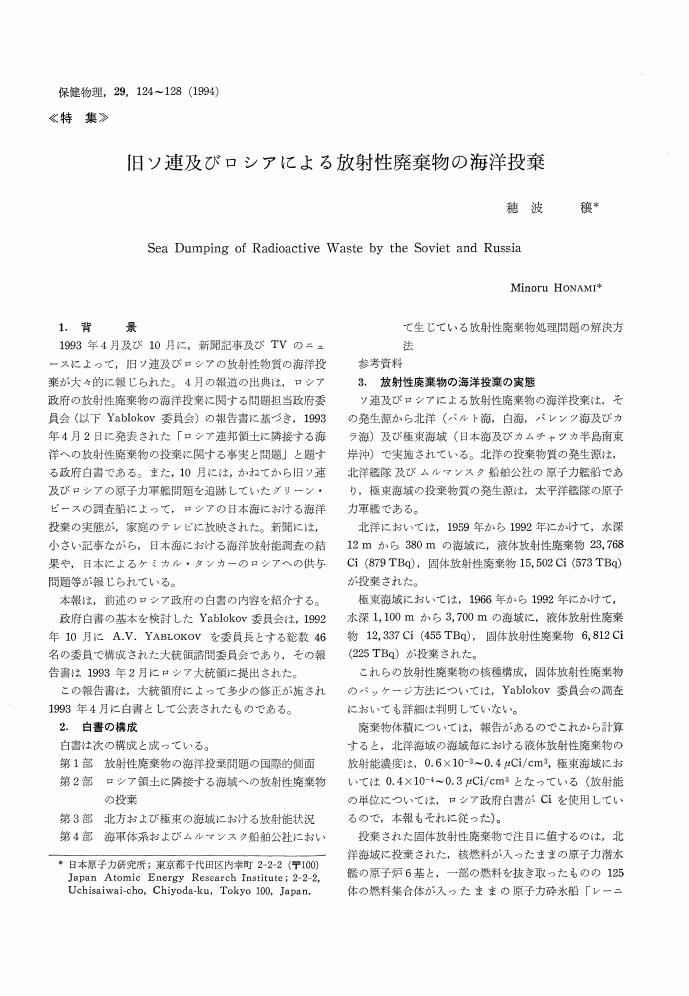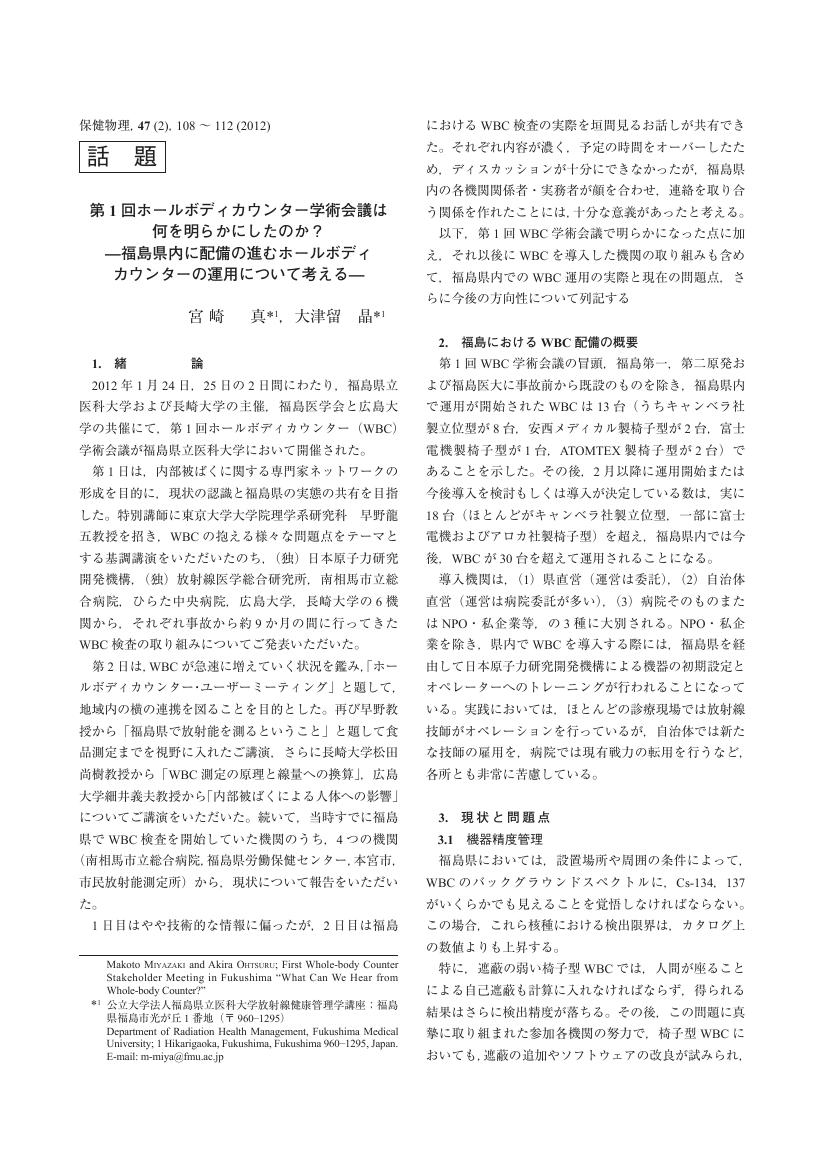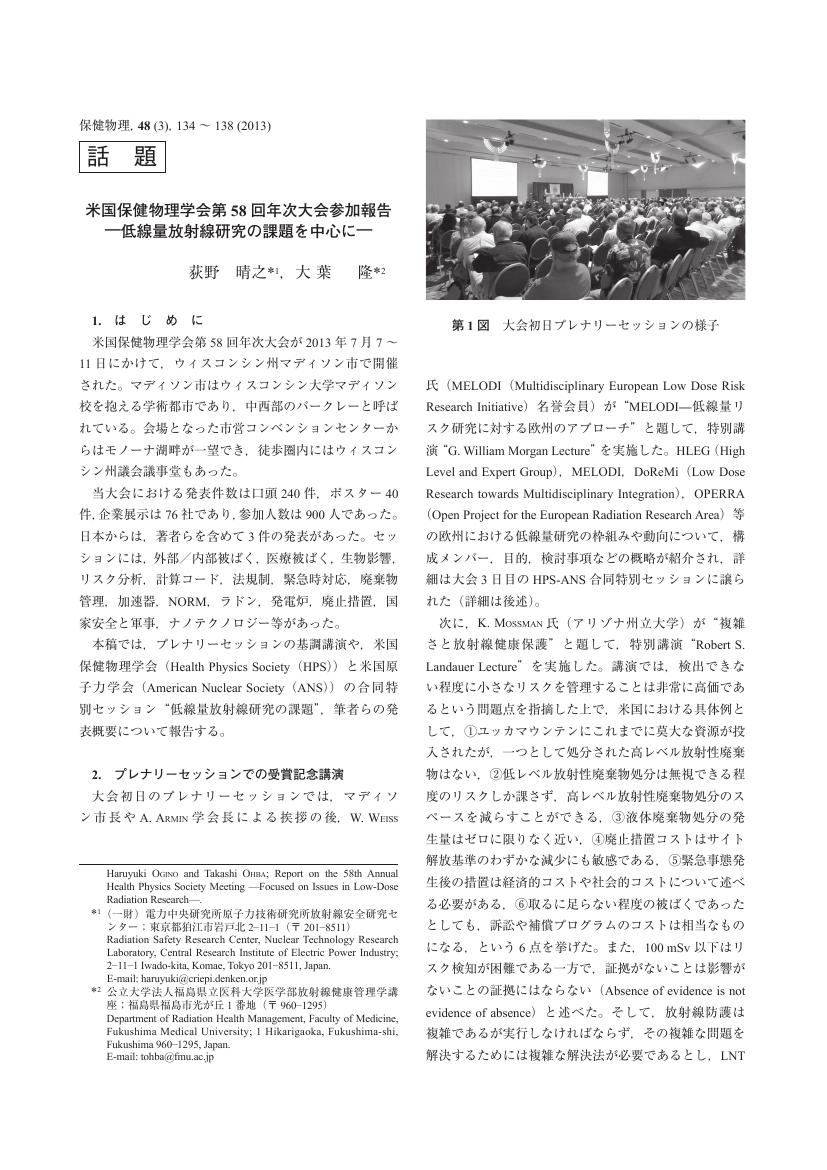327 0 0 0 OA 旧ソ連及びロシアによる放射性廃棄物の海洋投棄
- 著者
- 穂波 穣
- 出版者
- Japan Health Physics Society
- 雑誌
- 保健物理 (ISSN:03676110)
- 巻号頁・発行日
- vol.29, no.2, pp.124-128, 1994 (Released:2010-02-25)
241 0 0 0 OA 東海再処理施設周辺における東電福島第一原発事故後の降下じん中放射性物質濃度調査結果
- 著者
- 永岡 美佳 藤田 博喜 中野 政尚 渡辺 均 住谷 秀一
- 出版者
- 日本保健物理学会
- 雑誌
- 保健物理 (ISSN:03676110)
- 巻号頁・発行日
- vol.48, no.2, pp.104-113, 2013 (Released:2014-03-06)
- 参考文献数
- 25
- 被引用文献数
- 1 4
Monthly deposition samples were collected at the Nuclear Fuel Cycle Engineering Laboratories located about 115 km south of the Fukushima Daiichi Nuclear Power Plant (NPP), and the radioactive nuclides were analyzed. Although radionuclides such as 131I, 129mTe-129Te and 132Te-132I with 134Cs and 137Cs were observed by gamma spectrometry at the early time of the Fukushima Daiichi NPP accident, only 134Cs and 137Cs were detected as of September 2011. The annual depositions of 134Cs and 137Cs were about 19,000 and 17,000 Bq m-2, respectively in March 2011-February 2012 after the accident. Moreover, 90Sr was detected in some samples. Monthly 90Sr deposition in March 2011 was 5.1 Bq m-2 month-1 and then decreased after that. On the other hand, 239, 240Pu concentration was the same level with the concentration before the accident.
174 0 0 0 OA エートス (実用的放射線防護文化) の構築にむけて ―ICRP勧告111に基づいた自助による放射線防護―
- 著者
- 浜田 信行 ロイ E. ショア ローレンス T. ダウアー
- 出版者
- 日本保健物理学会
- 雑誌
- 保健物理 (ISSN:03676110)
- 巻号頁・発行日
- vol.53, no.2, pp.47-64, 2018 (Released:2018-09-13)
- 参考文献数
- 60
- 被引用文献数
- 2 4
For over four decades, a linear nonthreshold (LNT) model has been used for radiation protection purposes. In the United States of America, the National Council on Radiation Protection and Measurements (NCRP) established Scientific Committee 1-25 in 2015 to prepare a commentary to review recent epidemiologic data from studies with low doses or low dose rates and from the Life Span Study of atomic-bomb survivors to determine whether these epidemiologic studies broadly support the LNT model. In May 2018, NCRP published Commentary No. 27 “Implications of recent epidemiologic studies for the linear nonthreshold model and radiation protection”, noting that the ongoing development of science requires a constant reassessment of prior and emerging evidence to assure that the approach to radiation protection is optimal, even if not necessarily perfect. Based on the current epidemiological data, NCRP concluded that the LNT model (perhaps with excess risk estimates reduced by a dose and dose rate effectiveness factor) should continue to be utilized for radiation protection purposes. The Commentary will be used to support the work of NCRP Council Committee 1 who are charged to develop current radiation protection guidance for the United States, ultimately updating and expanding the basic radiation protection recommendations of NCRP Report No. 116 published in 1993. This review provides an outline and summary of the key points of NCRP Commentary No. 27.
114 0 0 0 OA 福島第一原子力発電所事故により放射性テルルで汚染された白米の経口摂取による預託実効線量
- 著者
- 藤原 慶子 高橋 知之 高橋 千太郎
- 出版者
- 日本保健物理学会
- 雑誌
- 保健物理 (ISSN:03676110)
- 巻号頁・発行日
- vol.51, no.1, pp.19-26, 2016 (Released:2016-07-06)
- 参考文献数
- 11
- 被引用文献数
- 4
The accident at the Fukushima nuclear power plant in 2011 caused the release of large amounts of tellurium (Te) isotopes, with radio-cesium (Cs) and radio-iodine (I), into the environment. The total amounts of 127mTe and 129mTe released from the nuclear power plant were estimated as 1.1 × 1015 and 3.3 × 1015 Bq, respectively. At the location where the deposition of 129mTe was relatively large, the ratio of the radioactivity of 129mTe to that of 137Cs reportedly reached 1.49 on June 14, 2011. Since 127mTe has a relatively long half-life, it possibly contributed to the internal radiation dose at the early stage after the accident. In this paper, the ratio of the committed effective dose of 127mTe to that of 137Cs after the oral ingestion of rice was estimated by using various reported parameters. The relevant parameters are: 1) the deposition ratios of 127mTe, 129mTe, and 134Cs to 137Cs; 2) the deposition ratio of 127mTe to 129mTe; 3) the transfer factors of Te and Cs; and 4) the effective dose coefficients for 127mTe, 129mTe, 134Cs, and 137Cs. The ratios of the committed effective dose of 127mTe to that of 137Cs were calculated for adults after a single ingestion at the time of the rice harvest. The ratio was 0.45 where the 129mTe/137Cs in the soil was higher and 0.05 where the level of 129mTe/137Cs was average. The ratio of the committed effective dose from 129mTe and 127mTe to that from 137Cs for one year reached 0.55 and 9.03 at the location where the level of 129mTe/137Cs in the soil was higher. These data could indicate that radioactive Te should not be disregarded in reconstructing the internal radiation dose from food for one year after the accident.
- 著者
- 斉藤 眞弘 石田 政弘
- 出版者
- Japan Health Physics Society
- 雑誌
- 保健物理 (ISSN:03676110)
- 巻号頁・発行日
- vol.20, no.2, pp.167-173, 1985 (Released:2010-02-25)
- 参考文献数
- 7
- 被引用文献数
- 1 2
83 0 0 0 OA 低レベル・トリチウムの遺伝的効果について
- 著者
- 堀 雅明 中井 斌
- 出版者
- Japan Health Physics Society
- 雑誌
- 保健物理 (ISSN:03676110)
- 巻号頁・発行日
- vol.11, no.1, pp.1-11, 1976 (Released:2010-02-25)
- 参考文献数
- 37
- 被引用文献数
- 1 1
Genetic risk assessment for potential hazard from environmental tritium to man becomes important with increasing nuclear-power industry. The purpose of this short review is to discuss the possible genetic effects of tritium from a view of genetic risk estimation.The discussion is based mainly on our experimental results on the chromosome aberrations induced in human lymphocytes by tritium at the very low-level. The types of chromosome aberrations induced by radiation from tritium incorporated into the cells are mostly chromatid types. The most interesting finding is that the dose-response relationship observed in both tritiated-water and tritiated-thymidine is composed of two phases. The examination on the nature of two-phase dose-response relationship is very important not only for the mechanisms of chromosome aberrations, but also for the evaluation of genetic risk from low-level radiation.
82 0 0 0 OA 粒子状放射性物質の再浮遊と移流による2次汚染
- 著者
- 飽本 一裕
- 出版者
- 日本保健物理学会
- 雑誌
- 保健物理 (ISSN:03676110)
- 巻号頁・発行日
- vol.49, no.1, pp.17-28, 2014 (Released:2015-02-26)
- 参考文献数
- 49
- 被引用文献数
- 1 4
In this report, several works on mainly resuspension and eolian transfer of radioactive cesium due to wind, which is one of the most effective transfer processes of previously deposited radioactive particulate materials, are introduced. First, the mechanisms of the resuspension of particulate matter by wind as well as resultant dust storms and wind erosion are surveyed. Next, the papers related to resuspension and eolian transfer of radioactive aerosols originally emitted by the Chernobyl nuclear accident are reviewed. The measured fallouts and radioactivity concentrations show annual cycles, and their peak periods depend on the measured regions. Finally, the works that analyze the related effects of the accident at the Fukushima Daiich Nuclear Power Plant are reviewed, and some issues to be focused and resolved are summarized.
64 0 0 0 OA 認識や理解の「ズレ」が除染を妨げている!?
63 0 0 0 OA 東海再処理施設から海洋放出されたトリチウムの海水中濃度及び拡散状況
- 著者
- 中野 政尚 國分 祐司 武石 稔
- 出版者
- 日本保健物理学会
- 雑誌
- 保健物理 (ISSN:03676110)
- 巻号頁・発行日
- vol.44, no.1, pp.60-65, 2009 (Released:2010-10-08)
- 参考文献数
- 15
- 被引用文献数
- 4
The tritium concentrations in seawater collected around the Tokai Reprpcessing Plant (TRP) were measured for 10,800 samples in 30 years from 1978. The tritium concentration, dillution factor and diffusion situation were investigated. As a result, the tritium was occationaly detected due to the discharge from TRP. But it was considered to be the result of expected diffusion assumed in the safety assessment. It was confirmed that the tritium concentration was much lower than the concentration limit defined in the law and that it was not concern of environmental safety.
46 0 0 0 OA 保健物理学会が見えない!
- 著者
- 田中 俊一
- 出版者
- 日本保健物理学会
- 雑誌
- 保健物理 (ISSN:03676110)
- 巻号頁・発行日
- vol.53, no.3, pp.133-134, 2018 (Released:2018-11-27)
- 被引用文献数
- 1
41 0 0 0 OA 東海再処理施設における排水中の超ウラン核種等に関する調査
- 著者
- 河野 恭彦 檜山 佳典 中野 政尚 武石 稔
- 出版者
- 日本保健物理学会
- 雑誌
- 保健物理 (ISSN:03676110)
- 巻号頁・発行日
- vol.44, no.2, pp.209-217, 2009 (Released:2010-11-02)
- 参考文献数
- 15
We surveyed the concentration levels of Transuranium (TRU) nuclides in the effluent discharged from the Tokai Reprocessing Plant (TRP) from 1998 to 2003 for Light Water Reactor (LWR) Fuel Reprocessing. The survey was performed for upcoming the effluent monitoring in Fast Breeder Reactor (FBR) Fuel Reprocessing. It was confirmed that the TRU nuclides concentration discharged from the TRP was 1/150∼1/106 much lower than the concentration limits authorized in governmental notification. Then, we compared the normalized discharge amounts by the unit of generated energy from the TRP with those from the foreign reprocessing plants. As a result, the TRP has reduced the amounts of discharged nuclides, by the order of 1/100-1/107 compared with foreign ones. This survey provided the important and basic data in order to compare the effluent of TRU nuclides in FBR and the present nuclear fuel cycles.
40 0 0 0 OA JCO臨界事故患者の初期治療
- 著者
- 鈴木 元
- 出版者
- Japan Health Physics Society
- 雑誌
- 保健物理 (ISSN:03676110)
- 巻号頁・発行日
- vol.35, no.1, pp.4-11, 2000 (Released:2010-02-25)
- 被引用文献数
- 1 2
39 0 0 0 OA 東海再処理施設と環境中のヨウ素-129
- 著者
- 中野 政尚
- 出版者
- 一般社団法人日本保健物理学会
- 雑誌
- 保健物理 (ISSN:03676110)
- 巻号頁・発行日
- vol.56, no.1, pp.17-25, 2021-03-31 (Released:2021-05-26)
- 参考文献数
- 33
- 被引用文献数
- 1
The Tokai Reprocessing Plant is the first reprocessing plant in Japan which started hot test in 1977, and had reprocessed 1,140 tons of spent nuclear fuel by May 2007. The gaseous and liquid radioactive wastes have been discharged to the environment. Since iodine-129 (129I) is one of the most important nuclides for the long-term environmental impact assessment. Therefore, 129I in the exhaust and effluent has been controlled, and precise analysis methods of 129I in the environmental samples have been developed, and the concentrations of 129I in the various environmental samples have been investigated. This report presents an overview of these activities. Not limited to 129I on the reprocessing facilities, it is essential for nuclear operators to reduce the amount released to the environment in the spirit of ALARA, and to continuously develop the further upgrading environmental monitoring methods and evaluation methods in order to foster a sense of safety and security among residents living in the vicinity of the facilities.
- 著者
- 工藤 伸一 石田 淳一 吉本 恵子 水野 正一 大島 澄男 古田 裕繁 笠置 文善
- 出版者
- 日本保健物理学会
- 雑誌
- 保健物理 (ISSN:03676110)
- 巻号頁・発行日
- vol.51, no.1, pp.12-18, 2016 (Released:2016-07-06)
- 参考文献数
- 16
- 被引用文献数
- 7
Radiation Effects Association has carried out radiation epidemiological study for nuclear industry workers during 1990-2010. We assembled a cohort of 204,103 workers. The average cumulative dose was 13.8 mSv (median 1.0 mSv, interquartile range (IQR) 0.0-10.7 mSv) and the average follow-up period was 14.2 year. The present report has not concluded that low-dose radiation increases cancer mortality based on the follow-up data through 2010. One reason is that analyses among 75,442 respondents― the average cumulative dose was 25.8 mSv (median 6.3 mSv, IQR 0.2-28.0 mSv) and the average follow-up period was 8.3 year―to the lifestyle surveys revealed the decrease of the ERR after adjusting for smoking habits or educational year, suggesting that confounder has a large effect on the association between radiation exposure and mortalities in the cohort. Another reason is that in analyses on all cohort members, no significant ERR was observed in all death, and leukemia excluding chronic lymphoid leukemia. Significant ERR was seen in all cancers excluding leukemia, but this significance of the ERR might be affected by confounder such as smoking, because the significance of the ERR in all cancers excluding leukemia originates in the significance of the ERR in lung cancer.
29 0 0 0 OA 放射性物質による皮膚汚染時の線量評価
- 著者
- 加藤 秀起 古賀 佑彦 向山 隆史 戸松 弘孝 鈴木 友輔 鈴木 昇一
- 出版者
- 日本保健物理学会
- 雑誌
- 保健物理 (ISSN:03676110)
- 巻号頁・発行日
- vol.44, no.4, pp.380-386, 2009 (Released:2011-01-12)
- 参考文献数
- 7
- 被引用文献数
- 3
In one of the accidents that might happen in the nuclear power station, there is a contamination accident caused by radioactive corrosion products during a periodic inspection. It is necessary to presume the skin absorbed dose from the adhesion area and the contamination density to forecast the level of the skin hazard by the adhesion of the radioactive substance. However, the data to forecast the local skin dose when the radioactive substance adhered handily is not maintained. In this paper, the absorbed dose in the skin surface neighborhood contaminated by radioactive corrosion products was calculated, and the relation between the adhesion area and the contamination density and the local absorption dose was derived. And, the approximate equation that forecast the integrated dose was derived from these data. As for the absorbed dose rate in depth 70 μm from the skin surface that became the index of the skin hazard, the contribution rate by 59Fe was the highest within 30 days, and the contribution of 60Co rose most after the 30th after the radioactive substance had adhered when the contamination density the adhesion area was the same. The relation between the initial contamination density and days that required it was graphed to reaching to the threshold by the integrated dose when the threshold dose in which the necrosis of the skin was caused was assumed to be 20 Gy. The absorbed dose commitment can be presumed from measurements of the contamination density by using this graph or the approximate equation.
26 0 0 0 OA 第1回ホールボディカウンター学術会議は何を明らかにしたのか?
23 0 0 0 OA 米国保健物理学会第58回年次大会参加報告
22 0 0 0 OA 日本人のヨード摂取量と甲状腺機能
- 著者
- 横山 直方
- 出版者
- 日本保健物理学会
- 雑誌
- 保健物理 (ISSN:03676110)
- 巻号頁・発行日
- vol.30, no.3, pp.243-250, 1995 (Released:2010-02-25)
- 参考文献数
- 18
21 0 0 0 OA 日本人の甲状腺における放射性ヨウ素の生物学的半減期に関する考察
- 著者
- 甲斐 倫明
- 出版者
- Japan Health Physics Society
- 雑誌
- 保健物理 (ISSN:03676110)
- 巻号頁・発行日
- vol.18, no.1, pp.3-10, 1983 (Released:2010-02-25)
- 参考文献数
- 36
- 被引用文献数
- 1 4 3
The purpose of the present study was to estimate a biological half-life of iodine in normal Japanese thyroid for the calculation of the thyroid dose from iodine-129 with a long physical half-life. The Japanese takes stable iodine through sea food in a more considerable amount than the Caucasian who is assumed to be the Reference Man recommended by ICRP. It can be shown by medical research in thyroidology that the iodine metabolism between the Japanese and the Caucasian is different owing to the amount of the ingested stable iodine. Furthermore, in the Japanese the thyroid releases inorganic iodine since it takes up iodine more than physiologically required to produce thyroid hormone.We calculated the biological half-life of iodine for both the Japanese and the Caucasian by using a five compartment model. The following results were delivered. The biological half-life in the Japanese was approximately 40 days, which was in agreement with the values reported before. On the other hand, that of the Caucasian was 130 days nearly equal to the Reference Man.








